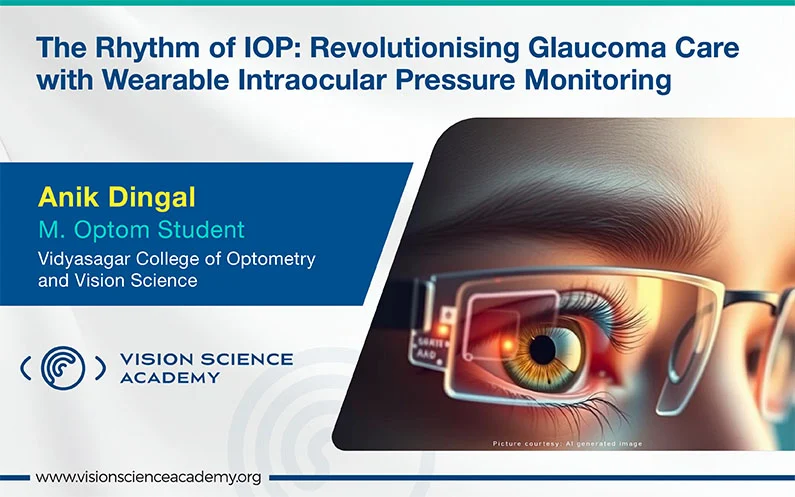Anik Dingal, B.Optom
M.Optom Student, Vidyasagar College of Optometry and Vision Science, Kolkata, India
Intraocular pressure (IOP) plays a critical role in maintaining eye health. Increased intraocular pressure (IOP) is a significant risk factor for glaucoma, which is one of the primary causes of permanent blindness globally. Early detection and continuous management of IOP are crucial to prevent vision loss. Recent advancements in wearable technology are revolutionising the way intraocular pressure is measured and managed, offering non-invasive, continuous, and accurate solutions for patients and healthcare providers.
Intraocular Pressure and Its Importance:
Intraocular pressure is the pressure exerted by the fluid within the eye. It is primarily regulated by the balance between aqueous humour production and its drainage. Abnormal IOP, either too high or too low, can damage the optic nerve, leading to vision loss. Regular IOP monitoring is essential for individuals at risk of glaucoma, but traditional methods have limitations. (1)
Challenges with Conventional IOP Measurement:
Conventional tools like tonometer’s, used during routine eye examinations, provide a snapshot of IOP at a single point in time. These measurements often miss fluctuations in IOP, which can vary throughout the day. Additionally, regular clinical visits can be inconvenient for patients, particularly for those requiring frequent monitoring.
Wearable Devices: Transforming IOP Monitoring:
Wearable technology offers a game-changing solution to these challenges. These innovative devices are designed to continuously monitor IOP, providing real-time data and insights into pressure variations.
- Smart Contact Lense:
- Smart contact lenses embedded with micro-sensors are among the most promising wearable technologies. These lenses detect changes in corneal curvature caused by IOP fluctuations and transmit the data wirelessly to a smartphone or cloud-based system. Patients can wear these lenses comfortably for extended periods, allowing for continuous monitoring. Examples include devices like Sensimed’s Triggerfish, which has received regulatory approval for use in glaucoma management, wireless theranostic contact lens. (2,3)
- Eyeglass-Based Systems:
- Another approach involves integrating IOP sensors into eyeglass frames. These devices use non-invasive techniques, such as pressure-sensitive films or optical sensors, to measure IOP. Eyeglass-based systems offer a convenient and discreet alternative for individuals who cannot wear contact lenses. (4)
- Implantable Devices:
- Although technically not wearable, implantable IOP sensors are worth mentioning. These tiny devices are surgically placed within the eye, providing continuous IOP data with unparalleled accuracy. They are particularly useful for high-risk patients who require rigorous monitoring.
- Wearable Eye Masks or Goggles:
- Example: Occulog
- Non-invasive devices worn like goggles or masks. Use advanced sensors to measure IOP, corneal thickness, or other ocular metrics. Often suitable for nighttime monitoring. (5)
- Example: Occulog
- Smart Patches:
- Adhesive patches placed near the eye, equipped with pressure sensors. Transmit data wirelessly to a connected device. (5)
Advantages of Wearable IOP Technology:
Wearable IOP devices offer numerous benefits:
- Continuous Monitoring: They track IOP fluctuations throughout the day, providing comprehensive data.
- Convenience: Patients can monitor their IOP from the comfort of their homes.
- Early Detection: Real-time data enables early intervention, reducing the risk of optic nerve damage.
- Patient Engagement: Wearable devices empower patients to actively participate in their care.
The Future of IOP Management:
The combination of artificial intelligence and big data with wearable IOP devices is set to transform glaucoma care. Predictive algorithms can examine IOP trends and notify both patients and healthcare providers of potential concerns before symptoms arise. Wearable devices for intraocular pressure monitoring signify a major advancement in eye care. By providing continuous, real-time tracking, these devices offer the potential for better patient outcomes, leading to more personalised and effective management of glaucoma and other ocular conditions. As technology progresses, the possibility of preserving vision for millions globally becomes increasingly attainable. (6)(7)
References:
- Machiele, R., Motlagh, M., Zeppieri, M., & Patel, B. C. (2024). Intraocular pressure. In StatPearls [Internet]. StatPearls Publishing.
- Kim, T. Y., Mok, J. W., Hong, S. H., Jeong, S. H., Choi, H., Shin, S., … & Hahn, S. K. (2022). Wireless theranostic smart contact lens for monitoring and control of intraocular pressure in glaucoma. Nature Communications, 13(1), 6801.
- Zhang, J., Kim, K., Kim, H. J., Meyer, D., Park, W., Lee, S. A., … & Lee, C. H. (2022). Smart soft contact lenses for continuous 24-hour monitoring of intraocular pressure in glaucoma care. Nature communications, 13(1), 5518.
- Zolfaghari, P., Yalcinkaya, A. D., & Ferhanoglu, O. (2023). Smart glasses to monitor intraocular pressure using optical triangulation. Optics Communications, 546, 129752.
- Wu, K. Y., Mina, M., Carbonneau, M., Marchand, M., & Tran, S. D. (2023). Advancements in Wearable and Implantable Intraocular Pressure Biosensors for Ophthalmology: A Comprehensive Review. Micromachines, 14(10), 1915.
- Sanchez, I., & Martin, R. (2019). Advances in diagnostic applications for monitoring intraocular pressure in Glaucoma: A review. Journal of optometry, 12(4), 211-221.
- De Smedt, S. (2015). Non-invasive intraocular pressure monitoring: current insights. Clinical ophthalmology, 1385-1392.


Recent Comments